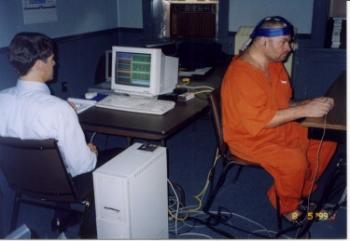 Dr. Lawrence Farwell has invented a technology that he believes will make torture obsolete. The system, which detects recognition of information stored in a subject’s brain, has already been used to convict a suspected murderer and more importantly, to exonerate a man convicted of a crime he did not commit.
Dr. Lawrence Farwell has invented a technology that he believes will make torture obsolete. The system, which detects recognition of information stored in a subject’s brain, has already been used to convict a suspected murderer and more importantly, to exonerate a man convicted of a crime he did not commit.
The Brain Fingerprinting system has proven 100 percent reliable in more than 120 tests involving the FBI, the US Navy, and tests involving real-life situations, such as actual crimes, reported the Fairfield Ledger.
In early tests Dr. Farwell scanned the brains of 21 people — 17 FBI new agent trainees along with 4 control subjects who lacked knowledge of the FBI. He correctly identified 100% of the 17 new agent trainees as FBI agents using an FBI-related stimulus presented on a computer screen.
When the brain recognizes a specific piece of information it triggers an electrical signal called the p300. The p300 bump is dectected between 300 and 800 milliseconds after a picture or word is presented to a subject that he or she recognizes.
The brain scan was used to exonerate Terry Harrington, jailed 23 years for a murder he did not commit. Details of the crime scene were not stored in Terry Harrington’s brain while his alabi was easily identified. The Brain Fingerprinting also helped wrap up a 15-year old murder case in Missouri leading to the conviction of James Grinder for the murder of Julie Helton (photo above).
Dr. Farwell’s technology also shows potential as an application for U.S. intelligence operations, such as detecting whether an individual has knowledge that would indicate that he had undergone training by a foreign intelligence or terrorist organization, according to Farwell’s Brain Wave Science website.
Given the current debate on what to do with prisoners at Guantanamo Bay, this would seem to be a perfect solution for sorting out how dangerous these people really are.
How can we urge our government to make use of this technology so it can be used to identify or exonerate suspected terrorists at Guantanamo Bay? Dr. Farwell suggests a “snail-mail” letter to President Obama and another to Secretary of State Clinton.
“Someone will read it and reply,” Farwell told me. “In the aggregate, these letters actually do make a difference because our representatives realize that for everyone who takes the time to write a letter there are many who feel the same way.”
Even if you live in Canada or another country, if you want to further the use of this innovation, Farwell suggests that you write. “The Obama administration, more than most previous administrations, cares about the views of our friends in Canada and around the world.”
Read more about this technology in the Farifield Ledger news report.




















I’m wary of using this type of technology, which is still in its infancy, in legal situations. I have a background in neuroscience and this article seems to overlook the debate which surrounds the topic.
If the evidence from brain scans is simply based on “recognition” of crime scenes, then it would be extremely simple to falsify results. For example, if an innocent person is repeatedly told/shown details of a crime scene, then I believe they would have the same activation pattern using this technology as someone who committed the crime and was shown details of the crime scene.
It may be useful, but the limitations of the technology should be made very clear if it is to be used in legal and other settings. This should be kept in mind if people are going to send letters to the president suggesting the use of this technology.